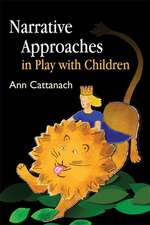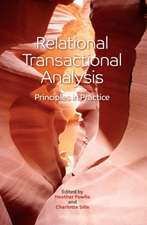Through Windows of Opportunity: A Neuroaffective Approach to Child Psychotherapy
Autor Marianne Bentzen, Susan Harten Limba Engleză Paperback – 16 ian 2015
| Toate formatele și edițiile | Preț | Express |
|---|---|---|
| Paperback (1) | 217.16 lei 6-8 săpt. | |
| Taylor & Francis – 16 ian 2015 | 217.16 lei 6-8 săpt. | |
| Hardback (1) | 818.69 lei 6-8 săpt. | |
| Taylor & Francis – 21 iun 2019 | 818.69 lei 6-8 săpt. |
Preț: 217.16 lei
Preț vechi: 273.81 lei
-21% Nou
Puncte Express: 326
Preț estimativ în valută:
41.55€ • 43.50$ • 34.38£
41.55€ • 43.50$ • 34.38£
Carte tipărită la comandă
Livrare economică 05-19 aprilie
Preluare comenzi: 021 569.72.76
Specificații
ISBN-13: 9781782201588
ISBN-10: 1782201580
Pagini: 304
Dimensiuni: 152 x 229 x 23 mm
Greutate: 0.45 kg
Ediția:1
Editura: Taylor & Francis
Colecția Routledge
Locul publicării:Oxford, United Kingdom
ISBN-10: 1782201580
Pagini: 304
Dimensiuni: 152 x 229 x 23 mm
Greutate: 0.45 kg
Ediția:1
Editura: Taylor & Francis
Colecția Routledge
Locul publicării:Oxford, United Kingdom
Public țintă
Professional Practice & DevelopmentCuprins
ABOUT THE AUTHORS FOREWORD Colwyn Trevarthen INTRODUCTION CHAPTER ONE The importance of present moments CHAPTER TWO Neuroaffective developmental psychology: a 'map' for understanding child psychotherapyCHAPTER THREE The autonomic compass and somatic experiencing CHAPTER FOUR The limbic compass and Theraplay CHAPTER FIVE The prefrontal compass and developmentally supportive conversations with childrenCHAPTER SIX The second growth spurt and multi-family mentalization-based therapyCHAPTER SEVEN The therapist in the role of caravan leader CHAPTER EIGHT Enacting the child's feelings in the psychotherapeutic processCHAPTER NINE Magic and transformationCHAPTER TEN Emotions, words, and mentalization CHAPTER ELEVEN Parental involvement CHAPTER TWELVE Closing remarks REFERENCES INDEX
Descriere
The basic argument of Through Windows of Opportunity is that skilled psychotherapists do similar things while describing them differently, and that psychological healing is created in the context of relationship.




















